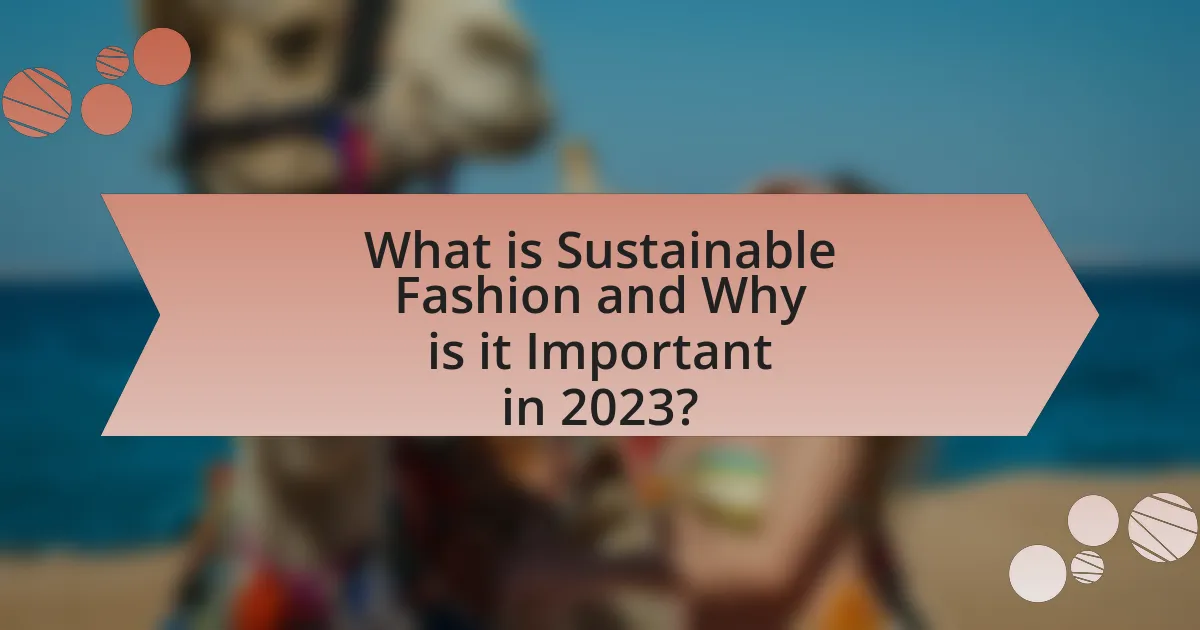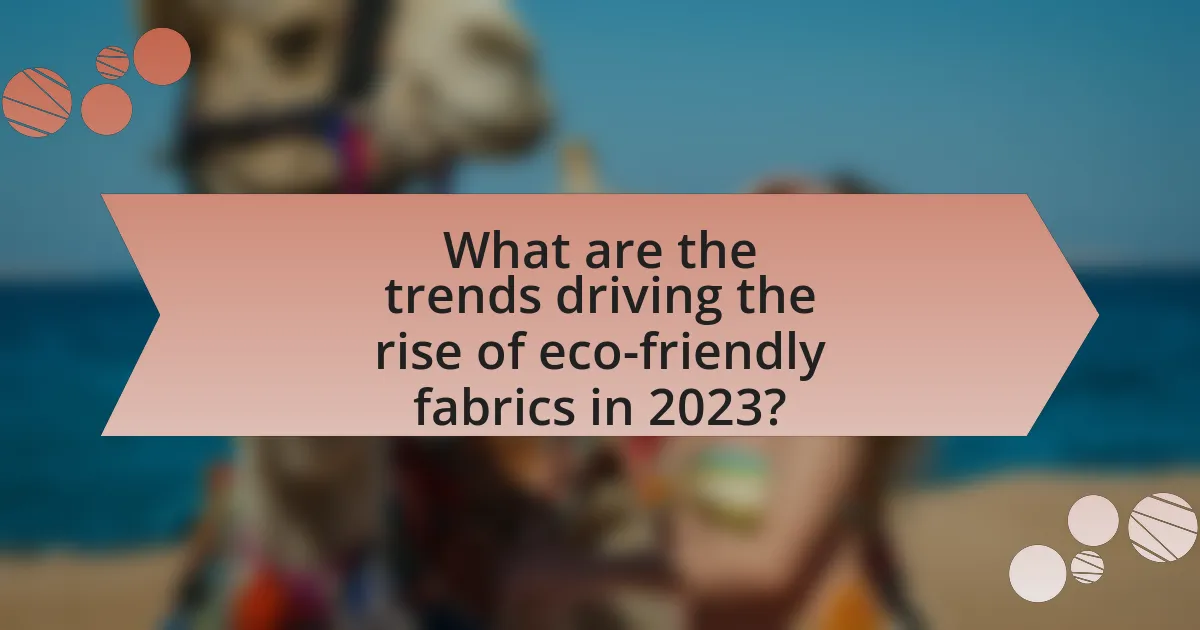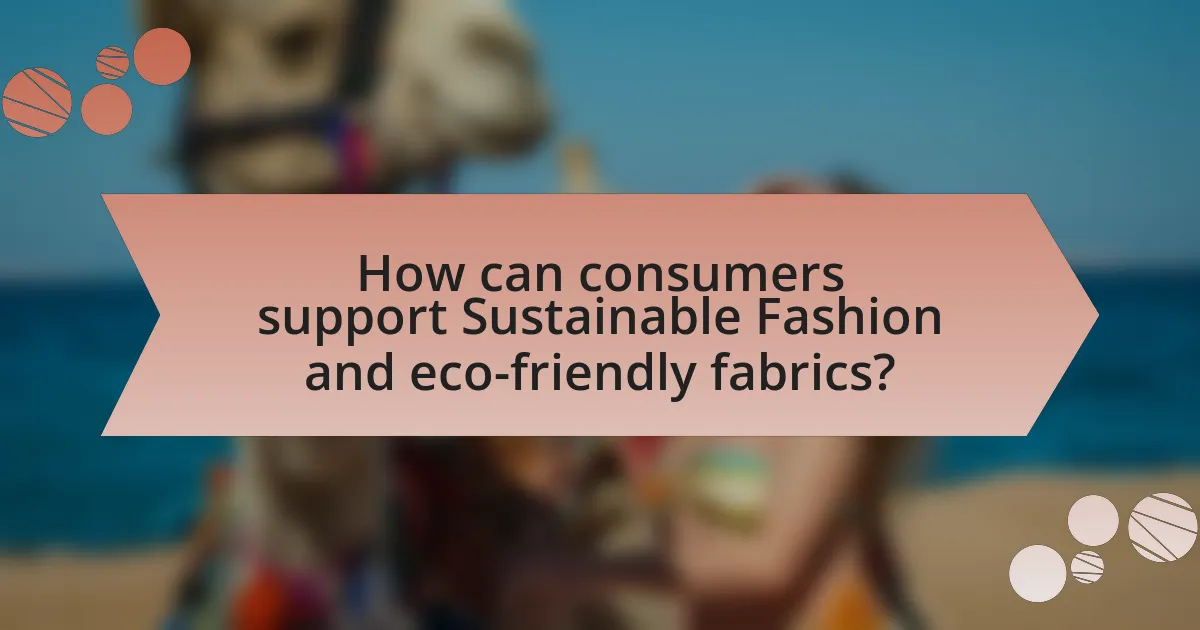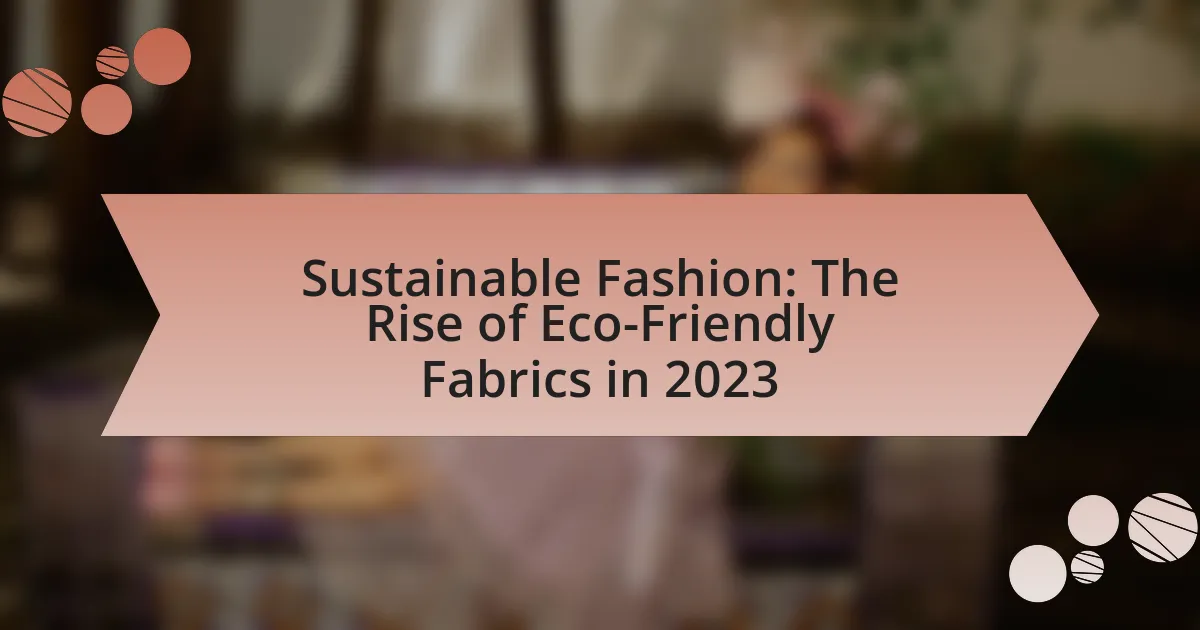Sustainable fashion is defined as clothing and accessories designed and produced with minimal environmental impact and a focus on social responsibility. In 2023, the importance of sustainable fashion is underscored by the fashion industry’s significant contribution to global carbon emissions and pollution. The article explores the differences between sustainable and traditional fashion, key principles of sustainability, the role of eco-friendly fabrics, and consumer awareness’s impact on the industry. It also discusses trends driving the adoption of sustainable materials, challenges brands face in sourcing these fabrics, and practical tips for consumers to support sustainable practices. The future of sustainable fashion appears promising, with innovations in fabric technology and evolving consumer behavior favoring eco-friendly options.

What is Sustainable Fashion and Why is it Important in 2023?
Sustainable fashion refers to clothing and accessories designed, produced, and consumed in ways that minimize environmental impact and promote social responsibility. In 2023, it is important because the fashion industry is one of the largest polluters globally, contributing to significant waste and carbon emissions. According to the United Nations, the fashion sector is responsible for 10% of global carbon emissions and is a major source of water pollution. As consumers increasingly demand eco-friendly practices, brands are adopting sustainable materials and ethical production methods to meet this expectation, thereby reducing their ecological footprint and fostering a more responsible industry.
How does Sustainable Fashion differ from traditional fashion?
Sustainable fashion prioritizes environmental and social responsibility, while traditional fashion often emphasizes profit and rapid production. Sustainable fashion utilizes eco-friendly materials, such as organic cotton and recycled fabrics, reducing waste and pollution, whereas traditional fashion frequently relies on synthetic materials and fast fashion practices that contribute to environmental degradation. For instance, the Ellen MacArthur Foundation reports that the fashion industry is responsible for 10% of global carbon emissions, highlighting the significant impact of traditional practices compared to the more sustainable approaches being adopted in eco-friendly fashion.
What are the key principles of Sustainable Fashion?
The key principles of Sustainable Fashion include ethical production, resource efficiency, and circularity. Ethical production emphasizes fair labor practices and humane working conditions, ensuring that workers are treated justly and compensated fairly. Resource efficiency focuses on minimizing waste and utilizing sustainable materials, such as organic cotton or recycled fibers, to reduce environmental impact. Circularity promotes the idea of designing products for longevity and recyclability, encouraging consumers to engage in practices like upcycling and responsible disposal. These principles collectively aim to create a fashion industry that prioritizes environmental health and social equity.
Why is consumer awareness crucial for Sustainable Fashion?
Consumer awareness is crucial for sustainable fashion because it drives demand for eco-friendly products and practices. When consumers are informed about the environmental and social impacts of their clothing choices, they are more likely to support brands that prioritize sustainability. For instance, a 2021 survey by McKinsey & Company found that 67% of consumers consider sustainability when making a purchase, indicating a significant shift towards eco-conscious buying behavior. This awareness not only influences purchasing decisions but also encourages brands to adopt sustainable practices, as they respond to consumer preferences for transparency and ethical production.
What role do eco-friendly fabrics play in Sustainable Fashion?
Eco-friendly fabrics are essential in sustainable fashion as they significantly reduce environmental impact. These materials, such as organic cotton, hemp, and recycled polyester, are produced with minimal use of harmful chemicals and resources, promoting a healthier ecosystem. For instance, organic cotton uses 91% less water than conventional cotton, highlighting its efficiency in resource conservation. Additionally, eco-friendly fabrics often utilize renewable resources and biodegradable materials, which help decrease waste in landfills. The adoption of these fabrics in the fashion industry supports a shift towards more sustainable practices, aligning with consumer demand for environmentally responsible products.
What are the most popular eco-friendly fabrics in 2023?
The most popular eco-friendly fabrics in 2023 include organic cotton, Tencel (lyocell), hemp, and recycled polyester. Organic cotton is favored for its reduced pesticide use and sustainable farming practices, while Tencel is known for its biodegradable properties and low environmental impact during production. Hemp is celebrated for its durability and minimal water requirements, making it a sustainable choice. Recycled polyester, made from post-consumer plastic bottles, helps reduce waste and energy consumption in fabric production. These fabrics are increasingly adopted in the fashion industry due to their environmental benefits and growing consumer demand for sustainable options.
How do eco-friendly fabrics impact the environment compared to conventional fabrics?
Eco-friendly fabrics significantly reduce environmental impact compared to conventional fabrics. Conventional fabrics, such as polyester and cotton, often require extensive water usage, harmful pesticides, and fossil fuels for production, contributing to pollution and resource depletion. In contrast, eco-friendly fabrics like organic cotton, hemp, and Tencel are produced with sustainable practices that minimize water consumption, eliminate toxic chemicals, and utilize renewable resources. For example, organic cotton uses 91% less water than conventional cotton and avoids synthetic pesticides, leading to healthier ecosystems. Additionally, Tencel is made from sustainably sourced wood pulp and is biodegradable, reducing landfill waste. These practices collectively contribute to lower carbon emissions and a smaller ecological footprint, making eco-friendly fabrics a more sustainable choice for the environment.

What are the trends driving the rise of eco-friendly fabrics in 2023?
The trends driving the rise of eco-friendly fabrics in 2023 include increased consumer awareness of environmental issues, advancements in sustainable textile technology, and regulatory pressures for sustainable practices. Consumers are increasingly prioritizing sustainability, with a 2022 survey indicating that 66% of global consumers are willing to pay more for sustainable brands. Technological innovations, such as the development of biodegradable materials and recycled fibers, are making eco-friendly fabrics more accessible and affordable. Additionally, governments and organizations are implementing stricter regulations on textile waste and carbon emissions, pushing brands to adopt sustainable practices. These factors collectively contribute to the growing demand for eco-friendly fabrics in the fashion industry.
How are brands adapting to the demand for eco-friendly fabrics?
Brands are adapting to the demand for eco-friendly fabrics by incorporating sustainable materials into their product lines and implementing environmentally responsible manufacturing processes. For instance, many companies are now using organic cotton, recycled polyester, and Tencel, which are known for their lower environmental impact compared to conventional fabrics. According to a report by McKinsey & Company, the global market for sustainable fashion is projected to grow significantly, indicating a strong consumer preference for eco-friendly options. Additionally, brands are increasingly adopting transparency in their supply chains, allowing consumers to trace the origins of materials and understand the sustainability practices involved. This shift not only meets consumer demand but also aligns with broader environmental goals, as evidenced by initiatives like the Fashion Pact, which aims to reduce the industry’s carbon footprint.
What innovations in fabric technology are emerging in 2023?
In 2023, innovations in fabric technology include the development of bio-based textiles, such as fabrics made from mycelium and algae, which significantly reduce environmental impact. These materials are biodegradable and produced using renewable resources, aligning with the sustainable fashion movement. For instance, mycelium leather alternatives are gaining traction for their low carbon footprint and minimal water usage compared to traditional leather production. Additionally, advancements in recycling technologies are enabling the transformation of post-consumer waste into high-quality fibers, further promoting circular fashion practices.
How are consumer preferences influencing fabric choices?
Consumer preferences are significantly influencing fabric choices by driving demand for sustainable and eco-friendly materials. As awareness of environmental issues grows, consumers increasingly prioritize fabrics made from organic, recycled, or biodegradable sources. For instance, a 2022 survey by McKinsey & Company found that 67% of consumers consider sustainability when making fashion purchases, leading brands to adopt materials like Tencel, organic cotton, and recycled polyester to meet this demand. This shift not only reflects changing consumer values but also compels manufacturers to innovate and invest in sustainable fabric technologies.
What challenges do brands face in sourcing eco-friendly fabrics?
Brands face several challenges in sourcing eco-friendly fabrics, primarily including limited availability, higher costs, and inconsistent quality. The limited availability of sustainable materials, such as organic cotton or recycled polyester, restricts brands’ options and can lead to supply chain disruptions. Higher costs associated with eco-friendly fabrics often deter brands from adopting them, as these materials can be more expensive than conventional alternatives. Additionally, inconsistent quality among eco-friendly fabrics can pose challenges in meeting consumer expectations for durability and performance. According to a report by McKinsey & Company, 66% of fashion executives cite sourcing sustainable materials as a significant barrier to achieving sustainability goals, highlighting the complexity of integrating eco-friendly fabrics into mainstream production.
How do supply chain issues affect the availability of eco-friendly materials?
Supply chain issues significantly reduce the availability of eco-friendly materials. Disruptions such as transportation delays, raw material shortages, and increased costs hinder manufacturers’ ability to source sustainable fabrics. For instance, the COVID-19 pandemic caused widespread supply chain disruptions, leading to a 30% decrease in the availability of organic cotton, a key eco-friendly material. Additionally, logistical challenges can result in longer lead times, making it difficult for brands to meet consumer demand for sustainable products.
What are the cost implications of using eco-friendly fabrics?
The cost implications of using eco-friendly fabrics typically involve higher initial production costs compared to conventional fabrics. This is primarily due to the more expensive raw materials, sustainable farming practices, and ethical labor conditions associated with eco-friendly textiles. For instance, organic cotton can cost up to 20% more than conventional cotton due to the absence of synthetic pesticides and fertilizers, which require more labor-intensive farming methods. Additionally, the production processes for eco-friendly fabrics often involve smaller-scale operations that prioritize sustainability over mass production, further increasing costs. However, these higher costs can be offset by consumer willingness to pay a premium for sustainable products, which has been shown to grow as awareness of environmental issues increases.

How can consumers support Sustainable Fashion and eco-friendly fabrics?
Consumers can support Sustainable Fashion and eco-friendly fabrics by choosing to purchase clothing made from sustainable materials, such as organic cotton, Tencel, or recycled polyester. These materials are produced with lower environmental impact, reducing water usage and chemical pollution. According to a report by the Global Fashion Agenda, sustainable materials can significantly decrease the carbon footprint of clothing production, with organic cotton using 91% less water than conventional cotton. Additionally, consumers can prioritize brands that are transparent about their supply chains and ethical practices, as this encourages more companies to adopt sustainable methods. Engaging in second-hand shopping and clothing swaps also extends the lifecycle of garments, further supporting eco-friendly practices.
What are practical tips for choosing sustainable clothing?
To choose sustainable clothing, prioritize brands that use eco-friendly materials, such as organic cotton, Tencel, or recycled fabrics. These materials reduce environmental impact by minimizing water usage and chemical pollution during production. Additionally, check for certifications like Global Organic Textile Standard (GOTS) or OEKO-TEX, which ensure adherence to sustainability standards. Supporting local or ethical brands can also contribute to reduced carbon footprints associated with transportation. Lastly, consider the durability of the clothing; investing in high-quality, timeless pieces reduces the need for frequent replacements, aligning with sustainable practices.
How can consumers identify truly sustainable brands?
Consumers can identify truly sustainable brands by examining their certifications, transparency in sourcing, and commitment to ethical practices. Certifications such as Global Organic Textile Standard (GOTS) and Fair Trade provide verifiable proof of a brand’s sustainable practices. Additionally, brands that openly share information about their supply chain and production processes demonstrate a commitment to transparency, which is a key indicator of sustainability. Research shows that brands with clear sustainability goals and measurable outcomes, such as reducing carbon emissions or using recycled materials, are more likely to be genuinely sustainable. For instance, a 2021 report by McKinsey & Company highlighted that 67% of consumers are willing to pay more for sustainable products, indicating a growing demand for accountability in the fashion industry.
What role does second-hand shopping play in Sustainable Fashion?
Second-hand shopping plays a crucial role in sustainable fashion by significantly reducing waste and resource consumption associated with clothing production. By purchasing pre-owned garments, consumers extend the lifecycle of clothing, thereby minimizing the demand for new items and the environmental impact of manufacturing processes. According to a report by the Ellen MacArthur Foundation, extending the life of clothing by just nine months can reduce carbon, water, and waste footprints by around 20-30%. This practice not only promotes a circular economy but also encourages mindful consumption, making it a key component of sustainable fashion initiatives.
What are the future prospects for Sustainable Fashion and eco-friendly fabrics?
The future prospects for sustainable fashion and eco-friendly fabrics are highly promising, driven by increasing consumer demand for environmentally responsible products. The global sustainable fashion market is projected to reach approximately $8.25 billion by 2023, reflecting a compound annual growth rate of 9.7% from 2019 to 2023, according to a report by Research and Markets. This growth is fueled by heightened awareness of environmental issues, such as pollution and waste generated by the fashion industry, prompting brands to adopt sustainable practices and materials. Innovations in eco-friendly fabrics, such as organic cotton, recycled polyester, and biodegradable textiles, are becoming more prevalent, further enhancing the appeal of sustainable fashion.
How might consumer behavior evolve in the coming years?
Consumer behavior is likely to evolve towards increased prioritization of sustainability and ethical practices in purchasing decisions. As awareness of environmental issues grows, consumers are increasingly seeking eco-friendly products, with a 2022 survey indicating that 66% of global consumers are willing to pay more for sustainable brands. This trend is expected to continue, driven by younger generations who prioritize sustainability, as evidenced by a 2021 report from McKinsey showing that 67% of Gen Z consumers consider sustainability when making purchases. Additionally, advancements in technology and transparency in supply chains will further influence consumer choices, as shoppers demand more information about the origins and environmental impact of their purchases.
What innovations can we expect in eco-friendly fabric development?
Innovations in eco-friendly fabric development include the creation of bio-based textiles, such as those derived from agricultural waste, and advancements in recycling technologies that transform post-consumer plastics into high-quality fibers. For instance, companies are increasingly utilizing materials like pineapple leaves, hemp, and organic cotton, which significantly reduce environmental impact compared to conventional fabrics. Additionally, innovations in dyeing processes, such as waterless dyeing and the use of natural dyes, are gaining traction, further minimizing water usage and chemical pollution. These developments are supported by research indicating that sustainable materials can reduce carbon footprints by up to 30% compared to traditional textiles, highlighting the effectiveness of these innovations in promoting sustainable fashion.
What are the best practices for integrating eco-friendly fabrics into your wardrobe?
To effectively integrate eco-friendly fabrics into your wardrobe, prioritize purchasing garments made from sustainable materials such as organic cotton, Tencel, or hemp. These fabrics are produced with less environmental impact compared to conventional textiles, as they often require fewer pesticides and water. Additionally, consider supporting brands that are transparent about their sourcing and manufacturing processes, as this ensures that the fabrics are not only eco-friendly but also ethically produced. Research indicates that the fashion industry is responsible for approximately 10% of global carbon emissions, highlighting the importance of choosing sustainable options. By selecting eco-friendly fabrics, consumers can significantly reduce their carbon footprint and contribute to a more sustainable fashion industry.
